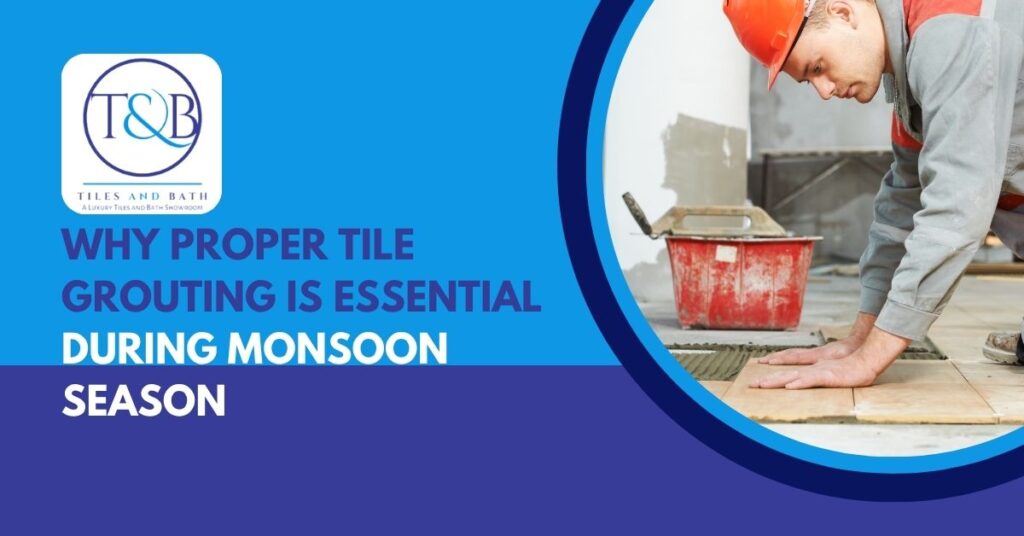The Role of Tile Grouting During Monsoon
With the onset of the monsoon season, Indian households begin facing increased moisture, water seepage, and the risk of mold and mildew—especially in bathrooms, kitchens, balconies, and utility areas. Among the many aspects of home improvement, tile grouting during monsoon stands out as one of the most overlooked yet essential elements.
Proper tile grouting not only enhances the appearance of tiled surfaces but also plays a crucial role in preventing water absorption and protecting the structural integrity of the floor and wall tiles. Without correct grouting, even the most expensive tiles can lead to long-term damage in monsoon-affected areas.
Understanding Tile Grouting and Its Purpose
Tile grouting refers to the process of filling gaps between tiles using a special compound that binds, seals, and waterproofs the space between each tile. In regions with high humidity or frequent rainfall, such as during the Indian monsoon, tile grouting must be done with precision and the right materials.
Choosing the correct grouting compound and ensuring proper application is critical to ensure tile grouting during monsoon prevents the entry of moisture, dust, and bacteria. It also prevents tiles from loosening or cracking under pressure caused by repeated wetting and drying.
Impact of Improper Grouting in Monsoon Conditions
One of the biggest mistakes homeowners make is overlooking worn-out or poorly applied grouting during monsoon. The consequences include:
- Water seepage beneath tiles leading to damp patches and peeling walls
- Growth of mold and mildew, especially in bathroom corners and kitchen backsplashes
- Increased chances of tile displacement or swelling
- Stains that permanently affect the surface appearance
These issues occur primarily because improperly sealed tile joints absorb excess moisture—a common problem observed during heavy rains. Hence, the need for professional tile grouting during monsoon becomes more significant than ever before.
Selecting the Right Grout for Monsoon-Proof Tiling
To ensure monsoon safety, it is essential to use the right type of grout based on the room type and level of exposure to moisture:
Cementitious Grout:
- Suitable for indoor areas with light to moderate moisture
- Requires sealing after application
- Commonly used but needs regular maintenance
Epoxy Grout:
- Ideal for high-moisture zones like bathrooms, terraces, and balconies
- Non-porous and highly durable
- Resistant to chemical damage and staining
When considering tile grouting during monsoon, epoxy-based grout is often the preferred choice due to its enhanced resistance to water absorption and its longer life span in wet environments.
Best Practices for Monsoon-Ready Tile Grouting
To maintain durability and avoid future repairs, follow these recommended practices:
- Always clean the tile joints thoroughly before grouting to avoid adhesion failure
- Choose a moisture-resistant grout suitable for wet areas
- Apply the grout evenly and allow it to cure completely before exposure to water
- Seal grout lines where necessary to add an extra layer of protection
- Inspect tile joints annually before the rainy season to ensure sealing is intact
These best practices are not only essential for preventing damage but also ensure the aesthetic longevity of your tiled spaces.
Grouting Maintenance Tips for Monsoon Season
Regular maintenance of grout lines enhances performance and appearance. Here are professional tips to manage tile grouting during monsoon effectively:
- Clean grout lines using pH-neutral cleaners to avoid chemical erosion
- Avoid bleach or harsh acids that can degrade cement-based grout
- Apply waterproof sealants at the start of the rainy season for extra protection
- Replace deteriorated or cracked grout before monsoon begins
- Hire professional tile installers for periodic regrouting in high-use areas
Such routine care ensures that tile installations remain safe, hygienic, and water-resistant even during the most humid days of the season.
The Connection Between Grouting and Long-Term Tile Durability
Grouting is not just a cosmetic feature—it significantly impacts the lifespan of tile surfaces. Without proper tile grouting, especially during monsoon, tiles are exposed to continual dampness, which causes warping, cracking, and detachment over time.
For wet zones like bathrooms and open balconies, using high-quality grout ensures water does not settle beneath the tiles. This prevents tile lifting and maintains a solid base structure. Therefore, homeowners who invest in professional tile grouting during monsoon benefit from reduced maintenance costs and long-term protection.
Conclusion: Invest in Proper Tile Grouting This Monsoon
Tile grouting may seem like a small component in your home’s construction or renovation, but its role in preserving your tiles during monsoon is undeniable. It is the first barrier against water infiltration, bacterial growth, and surface degradation. By investing in the right grout and skilled application, homeowners can protect their tiles and interiors for years to come.
At Tiles and Bath, we specialize in tile grouting solutions for monsoon and help you choose the right products based on your space, moisture exposure, and aesthetic preferences. Our expert recommendations, waterproof grouting options, and installation support are designed to withstand the unique challenges of the Indian monsoon.
Connect with Tiles and Bath for Expert Grouting Services
Looking to protect your floors and walls from monsoon damage?
Trust Tiles and Bath for professional guidance on:
- Water-resistant tile grouting for bathrooms and balconies
- Epoxy grout recommendations and application support
- Tile maintenance products for monsoon season



